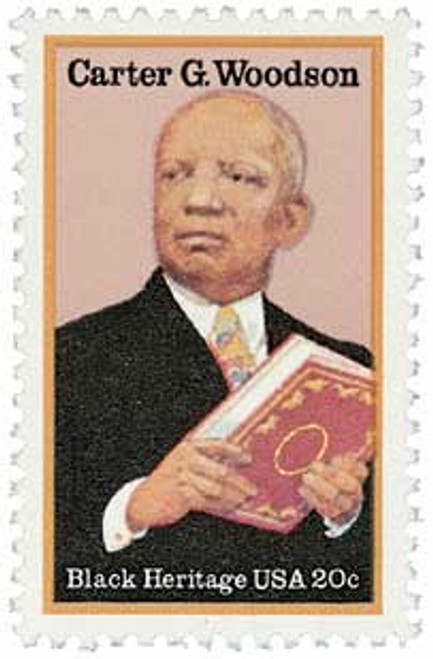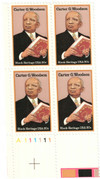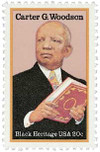
# 2073 - 1984 20c Black Heritage: Carter G. Woodson
U.S. #2073
1984 20¢ Carter G. Woodson
Black Heritage Series
- Seventh US Black Heritage stamp
- Honors the “Father of Black History” – Carter Woodson
Stamp Category: Commemorative
Series: Black Heritage
Value: 20¢, rate for first-class mail
First Day of Issue: February 1, 1984
First Day City: Washington, DC
Quantity Issued: 120,000,000
Printed by: American Bank Note Company
Printing Method: Photogravure
Format: Panes of 50 in Sheets of 200
Perforations: 11
Why the stamp was issued: To honor the "Father of Black History," Carter Woodson. Woodson overcame economic and social barriers to become the person most responsible for researching, writing, and teaching about the heritage of black Americans.
About the stamp design: This stamp was designed by Jerry Pinkney, who had designed all previous Black Heritage stamps. The Woodson portrait was based on a photo that hangs at the Association for the Study of Afro-American Life and History in Washington, DC, which Woodson founded. He flipped the image and made it longer, to show Woodson holding a book.
First Day City: Issued on the first day of Black History Month, the First Day ceremony for this stamp was held at the Shiloh Baptist Church in Washington, DC.
About the Black Heritage Series: The Black Heritage Series began on February 1, 1978, with the issue of the 13¢ Harriet Tubman stamp (US #1744). Since then, the USPS has issued a new stamp in the series every year. A number of them have even been released in February in recognition of Black History month. As of 2023, it was the USPS’s longest-running stamp series of all time.
History the stamp represents: Carter Godwin Woodson was born on December 19, 1875, in New Canton, Virginia. He was the second African American to earn a PhD from Harvard and has been called the Father of Black History.
Woodson was the son of former slaves who had aided Union soldiers during the Civil War. He rarely attended school when he was young because he had to help on the farm, but he taught himself as much as he could. When he was 17, Woodson went to Huntington, West Virginia to attend Douglass High School. He spent three years working in nearby coal mines before he was admitted in 1895. Woodson went on to teach and then attend Kentucky’s Berea College and the University of Chicago, where he earned his Bachelor and Master of Arts degrees. In 1912, he became the second African American (after W.E.B. Du Bois) to earn a PhD from Harvard.
After graduating, Woodson taught at public schools, served as a principal, and later as a professor and Dean of the College of Arts and Sciences at Howard University. Woodson had earned his PhD in history and was a member of the American Historical Association (AHA). However, the AHA didn’t allow him to attend conferences. Woodson felt he had no future in this profession and decided that he needed to create a new institutional structure to help African Americans study history. He received financial support from the Carnegie Foundation, the Julius Rosenwald Foundation, and the Rockefeller Foundation.
Woodson also felt that black history had been ignored or incorrectly represented by scholars around the world. He made it his goal to research their history and established the Association for the Study of Negro Life and History on September 9, 1915. His stated goal was “to treat the records scientifically and to publish the findings of the world” to avoid “the awful fate of becoming a negligible factor in the thought of the world.” Woodson published books on African American education, migration, religion, and history.
Through his work, Woodson sought to guide African Americans in conducting their own research and methodology. He worked with community leaders, teachers, churches, and women’s and civic groups to promote a better understanding of their history. In 1916, he published the first edition of the Journal of Negro History. The journal has been published continuously for over 100 years, though it’s now known as the Journal of African American History.
In 1926, Woodson staged Negro History during the second week in February, marking the birthdays of Abraham Lincoln and Frederick Douglass. Woodson said “It is not so much a Negro History Week as it is a History Week. We should emphasize not Negro History, but the Negro in History. What we need is not a history of selected races or nations, but the history of the world void of national bias, race hatred and religious prejudice.” Woodson’s idea was popular and grew over the years to include parades, lectures, and banquets. Then in 1970, February was established as Black History Month.
Woodson died from a heart attack on April 3, 1950. Schools, parks, and streets in 14 states and Washington, DC have been named in Woodson’s honor. In 1974, the Carter G. Woodson Book Award was established “for the most distinguished social science books appropriate for young readers that depict ethnicity in the United States.” His home in Washington, DC, has been preserved as national historic site. The Dr. Carter G. Woodson African American Museum was opened in St. Petersburg, Florida, in 2006.
U.S. #2073
1984 20¢ Carter G. Woodson
Black Heritage Series
- Seventh US Black Heritage stamp
- Honors the “Father of Black History” – Carter Woodson
Stamp Category: Commemorative
Series: Black Heritage
Value: 20¢, rate for first-class mail
First Day of Issue: February 1, 1984
First Day City: Washington, DC
Quantity Issued: 120,000,000
Printed by: American Bank Note Company
Printing Method: Photogravure
Format: Panes of 50 in Sheets of 200
Perforations: 11
Why the stamp was issued: To honor the "Father of Black History," Carter Woodson. Woodson overcame economic and social barriers to become the person most responsible for researching, writing, and teaching about the heritage of black Americans.
About the stamp design: This stamp was designed by Jerry Pinkney, who had designed all previous Black Heritage stamps. The Woodson portrait was based on a photo that hangs at the Association for the Study of Afro-American Life and History in Washington, DC, which Woodson founded. He flipped the image and made it longer, to show Woodson holding a book.
First Day City: Issued on the first day of Black History Month, the First Day ceremony for this stamp was held at the Shiloh Baptist Church in Washington, DC.
About the Black Heritage Series: The Black Heritage Series began on February 1, 1978, with the issue of the 13¢ Harriet Tubman stamp (US #1744). Since then, the USPS has issued a new stamp in the series every year. A number of them have even been released in February in recognition of Black History month. As of 2023, it was the USPS’s longest-running stamp series of all time.
History the stamp represents: Carter Godwin Woodson was born on December 19, 1875, in New Canton, Virginia. He was the second African American to earn a PhD from Harvard and has been called the Father of Black History.
Woodson was the son of former slaves who had aided Union soldiers during the Civil War. He rarely attended school when he was young because he had to help on the farm, but he taught himself as much as he could. When he was 17, Woodson went to Huntington, West Virginia to attend Douglass High School. He spent three years working in nearby coal mines before he was admitted in 1895. Woodson went on to teach and then attend Kentucky’s Berea College and the University of Chicago, where he earned his Bachelor and Master of Arts degrees. In 1912, he became the second African American (after W.E.B. Du Bois) to earn a PhD from Harvard.
After graduating, Woodson taught at public schools, served as a principal, and later as a professor and Dean of the College of Arts and Sciences at Howard University. Woodson had earned his PhD in history and was a member of the American Historical Association (AHA). However, the AHA didn’t allow him to attend conferences. Woodson felt he had no future in this profession and decided that he needed to create a new institutional structure to help African Americans study history. He received financial support from the Carnegie Foundation, the Julius Rosenwald Foundation, and the Rockefeller Foundation.
Woodson also felt that black history had been ignored or incorrectly represented by scholars around the world. He made it his goal to research their history and established the Association for the Study of Negro Life and History on September 9, 1915. His stated goal was “to treat the records scientifically and to publish the findings of the world” to avoid “the awful fate of becoming a negligible factor in the thought of the world.” Woodson published books on African American education, migration, religion, and history.
Through his work, Woodson sought to guide African Americans in conducting their own research and methodology. He worked with community leaders, teachers, churches, and women’s and civic groups to promote a better understanding of their history. In 1916, he published the first edition of the Journal of Negro History. The journal has been published continuously for over 100 years, though it’s now known as the Journal of African American History.
In 1926, Woodson staged Negro History during the second week in February, marking the birthdays of Abraham Lincoln and Frederick Douglass. Woodson said “It is not so much a Negro History Week as it is a History Week. We should emphasize not Negro History, but the Negro in History. What we need is not a history of selected races or nations, but the history of the world void of national bias, race hatred and religious prejudice.” Woodson’s idea was popular and grew over the years to include parades, lectures, and banquets. Then in 1970, February was established as Black History Month.
Woodson died from a heart attack on April 3, 1950. Schools, parks, and streets in 14 states and Washington, DC have been named in Woodson’s honor. In 1974, the Carter G. Woodson Book Award was established “for the most distinguished social science books appropriate for young readers that depict ethnicity in the United States.” His home in Washington, DC, has been preserved as national historic site. The Dr. Carter G. Woodson African American Museum was opened in St. Petersburg, Florida, in 2006.









